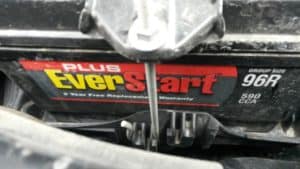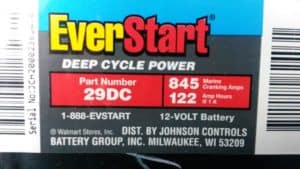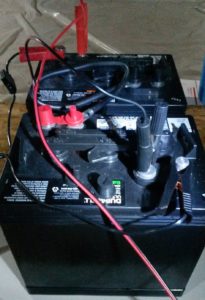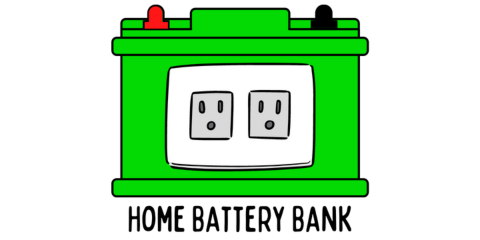Best Battery for Emergency Backup Power
When I built my own emergency battery bank for blackouts nearly a decade ago, I remember wanting to know the differences between car, marine, or golf cart batteries in order to make the best choice possible for my budget.
It’s more than the old adage, “you get what you pay for” when it comes to selecting the right battery. Just because they are all big bricks and weigh 40-60 lbs doesn’t mean they have the same intended purpose, chemistry, amp hours, and durability.
What’s the best flooded lead-acid battery for backup power?
The best flooded lead-acid battery for an emergency battery bank for blackouts would be a deep-cycle battery. Some Marine and all Golf Cart batteries are deep-cycle, with Golf Cart batteries typically giving the end user more bang for their buck — but they typically need to be purchased in sets of two and connected in series since most golf cart batteries are 6-volts.
As you continue, I’ll guide you through what I’ve experienced over the last 10 years about the pros and cons of each. I’ll also explain why I feel that if you’re on a tight budget a quality deep cycle marine battery will get you through most common power outages just fine, but if you have an extra $125 a set of golf cart batteries is the way to go.
Deep Cycle Batteries are the Best Battery Type for Emergency Power
In the lead-acid battery world (flooded, GEL, AGM), there are two primary types of batteries — starter batteries and deep-cycle batteries. The engineering behind each of these types of batteries is very different from one another, though they both look like 60 pound bricks from the outside.
Starter batteries are designed for that exact purpose — starting your car’s engine (or boat’s). These batteries have thin lead plates inside of them that are very close together in order to maximize the amount of amperage that can be drawn from them.
Starter batteries are great for quick bursts of energy and then are designed to be recharged by the vehicle’s alternator immediately afterward. Just imagine an Olympic sprinter. They will be great at 100m repeats, but they’ll exhaust quickly if you have them run the 10,000m.
Moreover, starter batteries quickly sulfate very quickly when discharged to any significant amount and are far more prone to this sulfation causing the battery to die a premature death.
Sulfation is when lead sulfate crystals form on the plates inside a lead-acid battery when it is in a state of discharge. The more a battery is below 100% state of charge, the quicker it will sulfate. The longer the battery remains in a state of discharge, the more permanent the lead sulfate crystals will become.
Generally, a starter battery can only be fully discharged between 10-15 times before dying and will no longer hold a charge.
On the other hand, deep-cycle batteries are engineered with thicker plates that are spread farther apart. This means that they cannot give off as much amperage up front, but they can maintain a low to moderate output (relative to the size of the battery bank’s total ampere hour rating) for a very long time.
Now, imagine an Olympic marathoner. They won’t even be in the same league as a sprinter, but they can go at a much lower speed for much longer without fatiguing. This is our deep-cycle battery.
Deep-cycle batteries also are less prone to damage by sulfation and can combat it easier during their next recharge. A deep-cycle battery can be fully discharged around 175 times.
TABLE
As you can see from the table, the clear winner for emergency backup power is the deep-cycle battery.
What Kind of Batteries are Deep-Cycle?
Golf cart batteries are all deep-cycle, as well as a good portion of marine batteries. Some marine batteries are “dual-purpose” and are a hybrid between the engineering of a deep-cycle and a starter battery. If you’re intending to get a battery for emergency backup power, it’s best to stick with deep-cycle.
You can find marine batteries in 12 or 24-volt options, with 12 being the most common. Most inverters that turn the battery’s DC current into usable AC current for appliances during an emergency are either 12 or 24-volt.
Golf cart batteries can be found in 6-volt (called GC2), 8-volt (called GC8), and 12-volt sizes (called GC12), with the GC2 being the most common. Buying two GC2 batteries and hooking them together in series creates a 12-volt battery. This is what I did for my system.
I have two GC2 batteries that are each 215Ah and 6-volts. They are hooked in series and are now 12-volts and 215Ah. This type of setup can provide around 150 combined full charges to all of my family’s electronic devices (phones, tablets, etc.). If running 5 LED lights for lighting in the house, it could run them for 13 days, assuming they were being used for 8 hours per day.
Best Deep Cycle Batteries for Emergency Power
Why Car Batteries are a Terrible Option for Emergency Power
What are we trying to achieve with a Battery Bank?
Before we get to the direct comparison let me just address what the purpose of a battery backup system is — in my humble opinion, of course.
If the power company is working on the lines outside the best alternative for power to keep your house running as close to normal as possible is a high wattage generator. Something 5000 kilowatts or higher will allow you to run the well pump and most everything in your house, though not necessarily at the same time.
A lower wattage generator might not allow you to run the well pump, but they will most likely run all of your other large draw appliances (microwaves, coffee makers, toasters, hair dryer, etc).
What is the battery bank supposed to do then? It is supposed to supplement your required lighting, media, and communications while your generator takes a break and while it is dark outside. That’s it and that’s all. For low-draw applications, a battery bank is infinitely more efficient than a generator.

When you wake up, go ahead and fire up the generator to brew some coffee and take showers. While you’re doing that, plug in your battery charger and top off the batteries that you used the night before.
Battery banks can be used to do things that require more power than basic lighting and device charging. However, you’ll quickly drain any of the following battery options in short order when compared to what their life expectancy could be if you only used them for the basics.
Battery Purpose, Cost, and Depth of Discharge and Life Expectancy:
Car:
Most everyone has access to one even without even considering their $70-$100 price tag. So why wouldn’t I want to use something that is already at my disposal for emergency battery power for the home? Well, this is a bit tricky to answer. Let’s look at the first side of the coin.

Once disconnected from the car, brought inside and used for its power, a car starting battery is going to be a short relief from a power outage. This battery is designed to quickly release its energy in a short burst to start the demands of a motor vehicle and be used at a mild rate while being simultaneously charged with that motor vehicle’s alternator.
Just think of that time when you were young and left the ONE interior light on inside the vehicle overnight and how you couldn’t crank the battery over in the morning. Yes, you’ll get some power but it won’t be long-lived, as it wasn’t designed to give the user sustained power over a long period of time.
Also, the car battery hates being discharged to any significant depth. It is a starting battery, the internal chemistry and makeup of the battery just won’t support a long draw of power. If you run the battery to full discharge around 10 times or so and recharge it back to its full state, you will not have a battery much longer. A shallow discharge (20-30% or so) can allow you 150 repeated charges. Properly maintained and in ideal temps, you’re looking at up to 5 years for its lifespan.
Now, let’s take a look at the other side of the coin. If you pull your vehicle up close to your dwelling (but outside the garage!) and leave the battery connected to the car and hook-up the power inverter, it can serve as an excellent temporary source of power. Just be sure to remember what is capable with a small battery backup system. With an 800-1,000+ watt power inverter, you could run a refrigerator (by itself only), multiple low-watt LED lights throughout the house and your small devices.
There are some drawbacks to this method, though. The primary one being that if it is still raining due to the storm, your inverter is not going to like you for getting it wet as it sits there exposed with your car hood open (and you can’t close it either or you risk cooking the inverter). So, the outdoor method can only be used if your weather permits and if you trust your neighbors not to steal anything or vandalize anything while you’re inside and your equipment is outside with a running car.
Marine (A true deep cycle, and not a starter/deep cycle hybrid) :
At $90-$120 per battery, this is definitely a viable option for a stand-alone system. Marine batteries are designed to be periodically discharged at various rates and recharged once the boat is docked. For shallow discharges (20-30%), you’re looking at over 1000+ recharges. They can also handle being fully discharged and brought back to life 175 times (plus or minus). If properly maintained and not regularly deeply discharged, you’re looking at a life expectancy of 5+ years.

They are designed to give out energy over a long draw time. One 100 Amp Hour Group 27 or 29 deep cycle battery would be my recommendation for anyone on a tight budget who just wants to make sure they can run a couple lights and power a device or two periodically throughout the storm.
You could hook-up two of them in parallel and get twice the amount of ampere-hours out if the ordeal… but if you’re willing to buy a second battery for that added power I encourage you to meet my favorite option – the Golf Cart battery!
Golf Cart:
Last but not least we have the $99-$120 Golf Cart battery… but the difference is that the ones you’ll find at that price are 6 volts (called GC2 batteries) and we need to have 12 volts to run the power inverter. You’ll need to buy two of these and hook them up in series to double their combined voltage (amp hours will remain the same when connected in series).

Now, think of your intoxicated uncle Frank and how much he abuses these batteries as he recklessly drives that golf cart on the back nine – starting and stopping and hitting every bump along the way. These batteries are designed to be tossed around, discharged daily/weekly and keep on trucking.
You’ll get significantly more shallow, moderate, and deep discharge tolerances than the marine deep cycle batteries. The life expectancy is 7-10 years if properly maintained and not regularly deeply discharged. For around $200-$240 (battery cost only) you’ll have a basic system set up that will give you an excellent source of power over a long period of time.
By “excellent source of power” I am assuming that we all remember the limitations of a battery backup system and its ideal purpose. Remember, generators are what you want and need to use in a blackout if you’re looking to run the coffee maker, toaster, electric stove, well pump, central air, air conditioning window unit, large TV, etc.
But if you’re looking to power 6 x 4 watt LED lights in your house at night, charge your family’s devices periodically, and listen to the radio until morning arrives – then the golf cart system or marine battery system will work great for days and days without requiring a recharge.
General Cost of a Car, Marine, or Golf Cart Battery Bank
When it comes down to it, money is really the deciding factor (isn’t it always?!) when it comes to your battery purchase for a basic DIY battery backup system. If all you have is $50 and a car, I recommend making do with what you have. Purchase a 400-watt power inverter and use it to power what you can while the weather is nice and neighbors permitting. If you have to you can bring the battery inside to charge up a cell phone and run a string of led Christmas lights. Hopefully, you have flashlights on hand to save your battery for your car in the morning!
If you’ve got $200-$225, you can have the basic setup to get a single deep cycle marine battery, a single inverter, and a quality charger and maintainer. This is absolutely a viable option for an apartment or if you’re just getting your home backup system set up.
Finally, if you’ve got $325-350, you’ll be able to get two GC2 golf cart batteries, an inverter, and quality charger. To get the best bang for your buck, you’ll get the most amp hours per dollar and the most durability due to better lead and chemistry within the batteries. As long as you understand what a battery bank is intended for and its limitations, you won’t be disappointed with a pair of GC2 Golf Cart batteries to keep things normal at night during a power outage!

